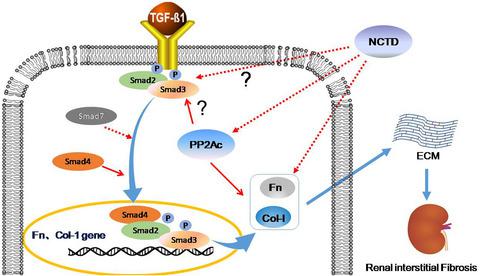当前位置:
X-MOL 学术
›
Chem. Bio. Drug Des.
›
论文详情
Our official English website, www.x-mol.net, welcomes your
feedback! (Note: you will need to create a separate account there.)
Anti‐renal interstitial fibrosis effect of norcantharidin is exerted through inhibition of PP2Ac‐mediated C‐terminal phosphorylation of Smad3
Chemical Biology & Drug Design ( IF 3.2 ) Pub Date : 2020-09-07 , DOI: 10.1111/cbdd.13781 Han-Wen Luo 1 , Dan-Dan Yin 2 , Zheng Xiao 1 , Lu Wen 1 , Ying-Jun Liao 1 , Cheng-Yuan Tang 1 , Dong Zeng 1 , Heng-Ting Xiao 1 , Ying Li 1
Chemical Biology & Drug Design ( IF 3.2 ) Pub Date : 2020-09-07 , DOI: 10.1111/cbdd.13781 Han-Wen Luo 1 , Dan-Dan Yin 2 , Zheng Xiao 1 , Lu Wen 1 , Ying-Jun Liao 1 , Cheng-Yuan Tang 1 , Dong Zeng 1 , Heng-Ting Xiao 1 , Ying Li 1
Affiliation

|
Norcantharidin (NCTD), the demethylated analog of cantharidin isolated from Mylabris, is known to inhibit renal fibrosis. However, the underlying mechanism is largely unknown. The present study investigates whether NCTD exerts this effect through regulation of the protein phosphatase 2A catalytic subunit (PP2Ac)‒Smad3 pathway. HK‐2 human renal proximal tubule cells exposed to transforming growth factor (TGF)‐β1 were used as an in vitro model of renal fibrosis. The levels of total Smad3, C‐terminal‐phosphorylated Smad3 (p‐Smad3), PP2Ac, and fibronectin (Fn) were evaluated by Western blotting. A PP2Ac overexpression plasmid and the PP2Ac inhibitor okadaic acid (OA) were used for functional analyses. The subcellular localization of Smad3 was visualized by immunofluorescence labeling. The results showed that PP2Ac overexpression increased Smad3 phosphorylation and nuclear translocation in HK‐2 cells, while pharmacologic inhibition of PP2Ac with OA had the opposite effect. NCTD suppressed Fn and p‐Smad3 expression and TGF‐β1‐induced nuclear entry of Smad3, but these effects were abrogated by inhibition of PP2Ac. Thus, the anti‐renal interstitial fibrosis effect of NCTD is exerted through inhibition of PP2Ac‐mediated C‐terminal phosphorylation of Smad3. These findings highlight the therapeutic potential of NCTD for the treatment of renal interstitial fibrosis.
中文翻译:

去甲斑蝥素的抗肾间质纤维化作用是通过抑制 PP2Ac 介导的 Smad3 的 C 端磷酸化发挥的
Norcantharidin (NCTD),从Mylabris 中分离的斑蝥素的去甲基化类似物, 已知可抑制肾纤维化。然而,潜在的机制在很大程度上是未知的。本研究调查 NCTD 是否通过调节蛋白磷酸酶 2A 催化亚基 (PP2Ac)-Smad3 通路发挥这种作用。暴露于转化生长因子 (TGF)-β1 的 HK-2 人肾近端小管细胞被用作肾纤维化的体外模型。通过蛋白质印迹评估总 Smad3、C 端磷酸化 Smad3(p-Smad3)、PP2Ac 和纤连蛋白(Fn)的水平。PP2Ac 过表达质粒和 PP2Ac 抑制剂冈田酸 (OA) 用于功能分析。Smad3 的亚细胞定位通过免疫荧光标记可视化。结果表明,PP2Ac 过表达增加了 HK-2 细胞中 Smad3 的磷酸化和核易位,而 PP2Ac 与 OA 的药理抑制作用则相反。NCTD 抑制 Fn 和 p-Smad3 表达以及 TGF-β1 诱导的 Smad3 进入核,但这些作用被 PP2Ac 的抑制所抵消。因此,NCTD 的抗肾间质纤维化作用是通过抑制 PP2Ac 介导的 Smad3 C 末端磷酸化来发挥的。这些发现突出了 NCTD 在治疗肾间质纤维化方面的潜力。
更新日期:2020-09-07
中文翻译:

去甲斑蝥素的抗肾间质纤维化作用是通过抑制 PP2Ac 介导的 Smad3 的 C 端磷酸化发挥的
Norcantharidin (NCTD),从Mylabris 中分离的斑蝥素的去甲基化类似物, 已知可抑制肾纤维化。然而,潜在的机制在很大程度上是未知的。本研究调查 NCTD 是否通过调节蛋白磷酸酶 2A 催化亚基 (PP2Ac)-Smad3 通路发挥这种作用。暴露于转化生长因子 (TGF)-β1 的 HK-2 人肾近端小管细胞被用作肾纤维化的体外模型。通过蛋白质印迹评估总 Smad3、C 端磷酸化 Smad3(p-Smad3)、PP2Ac 和纤连蛋白(Fn)的水平。PP2Ac 过表达质粒和 PP2Ac 抑制剂冈田酸 (OA) 用于功能分析。Smad3 的亚细胞定位通过免疫荧光标记可视化。结果表明,PP2Ac 过表达增加了 HK-2 细胞中 Smad3 的磷酸化和核易位,而 PP2Ac 与 OA 的药理抑制作用则相反。NCTD 抑制 Fn 和 p-Smad3 表达以及 TGF-β1 诱导的 Smad3 进入核,但这些作用被 PP2Ac 的抑制所抵消。因此,NCTD 的抗肾间质纤维化作用是通过抑制 PP2Ac 介导的 Smad3 C 末端磷酸化来发挥的。这些发现突出了 NCTD 在治疗肾间质纤维化方面的潜力。









































 京公网安备 11010802027423号
京公网安备 11010802027423号